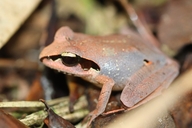|
Description
M 41 mm, F up to 53 mm. Tibiotarsal articulation reaches beyond snout tip. Hands without webbing, foot webbing 1(0.5), 2i(1-1.5), 2e(0.5), 3i(1.5-2), 3e(0.5-1), 4i(2), 4e(1.5), 5(0-0.5). Dorsal skin smooth. Dorsally uniformly brown with black markings laterally on head and in inguinal region as typical for the genus. Males with a slightly extensible single subgular vocal sac, and a partly yellowish colour when in breeding condition.
Distribution and Habitat
Country distribution from AmphibiaWeb's database: Madagascar
Andasibe, Marojejy, Montagne d’Ambre, Ranomafana National Park, Vohiparara. Many other localities are known but it is uncertain whether they are to be assigned to Aglyptodactylus madagascariensis or to any of the cryptic species. From sea level to 2000m asl (IUCN 2008).
Life History, Abundance, Activity, and Special Behaviors
Outside of the breeding season commonly encountered on the forest floor where it escapes with impressing leaps. Explosive breeder, reproduces in temporary stagnant waters after heavy rains. Calling males sit next to or in the water. Eggs are laid into the ponds where the tadpoles develop.
Calls: Slow and loud series of 3-5 pulsed notes.
Comments
A. madagascariensis as previously understood is a complex of various species which occur in different elevational ranges and different areas of eastern Madagascar. The description given here refers to species from mid-elevations that we consider to be typical A. madagascariensis, but a morphological revision of this complex is missing.
Other forms mentioned in Glaw and Vences (2007) include:
A. sp. aff. madagariensis "South": low-elevation rainforest in Anandohahela National Park; sister lineage of typical A. madagascariensis; habits and calls unknown.
A. sp. aff. madagariensis "Ranomafana": from several low-elevation sites in south-eastern Madagascar, from Tolagmaro to Ranomafana where it occurs next to Ranomafana village, while at higher elevations in Ranomafana National Park, typical A. madagascariensis can be found. It is smaller than typical A. madagascariensis, and breeding males are characterized by a dorsally and ventrally yellow colour with multiple keratinized spines on the ventral side, and distinct nuptial pads. Near Tolagmaro, calling males were sitting at night on the edge of a pond, and the calls were series of 3-4 pulsed notes.
A. sp. aff. madagariensis "East": A further sibling species of A. madagascariensis from eastern coastal habitats. The only reliable locality for this species is Maroansetra village, where specimens were collected on the sandy ground next to a small spring outside of the breeding season. The strong molecular differentiation of this species leaves no doubt of its status as separate species. It is likely that this species also populates other low-elevational habitats on Masoala Peninsula and the east coast.
Taken with permission from Glaw and Vences (2007).
References
Datong, Y., and Shunqing, L. (2004). Cynops cyanurus. In: IUCN 2008. 2008 IUCN Red List of Threatened Species. www.iucnredlist.org. Downloaded on 11 March 2009.
Glaw, F., and Vences, M. (2007). Field Guide to the Amphibians and Reptiles of Madagascar. Third Edition. Vences and Glaw Verlag, Köln.
Originally submitted by: Frank Glaw and Miguel Vences (first posted 2002-02-08)
Edited by: Kellie Whittaker (2010-07-19)Species Account Citation: AmphibiaWeb 2010 Aglyptodactylus madagascariensis <https://amphibiaweb.org/species/4326> University of California, Berkeley, CA, USA. Accessed Nov 23, 2024.
Feedback or comments about this page.
Citation: AmphibiaWeb. 2024. <https://amphibiaweb.org> University of California, Berkeley, CA, USA. Accessed 23 Nov 2024.
AmphibiaWeb's policy on data use.
|
